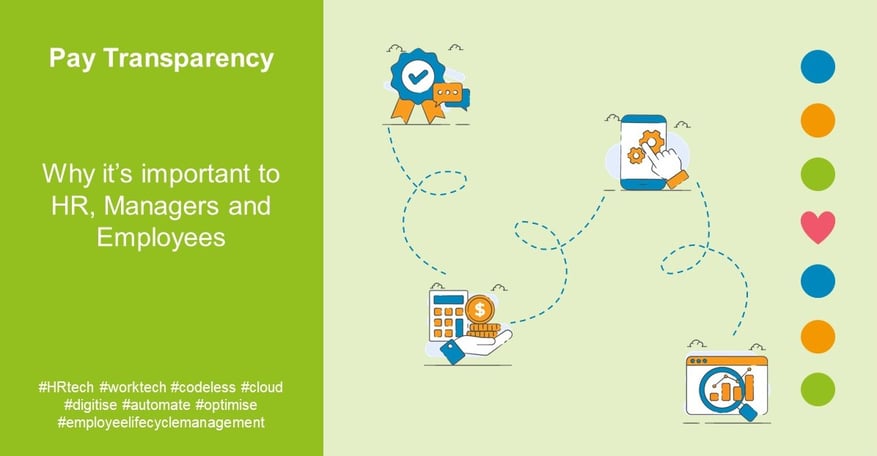Pay transparency has been gaining massive momentum in recent years. Employees are now calling for greater visibility into salaries, and lawmakers are responding by considering pay transparency as a legal requirement. Embracing pay transparency has become crucial for organisations to attract top talent and establish a fair and equitable workplace.
The conversation around pay transparency has shifted dramatically, emphasising the importance of open communication and fostering an equitable work environment. Pay transparency promotes employee engagement, fosters a stronger company culture, attracts a wider pool of talent, and ultimately enhances business performance.
But why exactly does your organisation no longer have any choice but to consider pay transparency? Let’s find out 👇

Understanding Pay Transparency
Pay transparency refers to the practice of openly sharing employee salary information within an organisation or during the hiring process. It involves disclosing details about compensation, such as salary ranges, pay scales, and salary bands. This transparency allows employees and candidates to have a clearer understanding of the financial aspects of their roles and promotes a more open and equitable work environment. 👍
➡️ There are several significant benefits associated with pay transparency.
Firstly, it leads to increased employee engagement and satisfaction. When employees have access to salary information, they feel more empowered and valued, which in turn enhances their motivation and commitment to their work.
Transparent pay practices also contribute to a sense of fairness and trust within the organisation, as employees can see that compensation decisions are based on objective criteria.
Pay transparency plays a vital role in reducing gender and minority pay gaps. When organisations openly share salary information, they can identify and address any disparities in compensation that might exist due to factors such as gender, race, or ethnicity. This helps create a more equitable workplace where everyone is paid fairly for their skills and contributions.
Pay Transparency Laws in Australia: What You Need to Know

In Australia and NZ, pay transparency is not only a growing trend but also a legal requirement in certain cases. The Pay Transparency Act sets out specific provisions and requirements that organisations must adhere to. It aims to promote fair and equitable pay practices and eliminate pay discrimination.
The key provisions of the Pay Transparency Act include the obligation for companies to disclose pay scales, salary ranges, or other relevant compensation information during the hiring process. This ensures that candidates have access to salary information and can make informed decisions about job opportunities.
🧨 Failure to comply with the requirements of the Pay Transparency Act can result in penalties and fines for organisations. The exact consequences might vary depending on the severity and frequency of non-compliance.
That’s why it's crucial for employers to understand their obligations under the act to avoid legal implications and potential reputational damage.
The Equal Pay Act in Australia
In addition to the Pay Transparency Act, Australia has also enacted the Equal Pay Act to address gender-based pay discrimination. This act aims to achieve pay equality between men and women in the workforce. Pay transparency plays a significant role in supporting equal pay initiatives.
When they implement pay transparency practices, organisations can identify and address any gender-based pay disparities that might exist within their workforce. Transparent salary information allows employers to evaluate their compensation practices and ensure that employees receive equal pay for equal work.
Pay transparency contributes to equal pay initiatives by shedding light on potential pay gaps and fostering a culture of fairness and equality. It encourages organisations to review and adjust their compensation policies to eliminate gender-based pay discrimination.
The Advantages and Disadvantages of Pay Transparency
Pay transparency has its advantages and disadvantages, which organisations should carefully consider before implementing such practices. Understanding both sides is essential to make informed decisions. Let's delve into the advantages and disadvantages of pay transparency. ⬇️

Advantages of Pay Transparency
✅ Improved organisational culture
Implementing pay transparency can have a significant impact on improving organisational culture.
Pay transparency fosters open communication within the organisation. When employees have access to information about salary structures and compensation practices, it promotes transparency and eliminates the secrecy surrounding pay.
This transparency encourages conversations about compensation, creating an environment where employees feel comfortable discussing their salaries openly. As a result, it builds trust among employees and reduces the perception of favouritism or inequality. Open communication about pay can also lead to discussions about career growth and development, allowing employees to align their goals with the organisation's compensation structure.
In environments where pay information is kept confidential, rumours and speculation about salary disparities often arise. This can create a toxic work environment and lead to decreased employee morale. With pay transparency, organisations can minimise rumours and speculation related to compensation.
When employees have access to clear information about pay ranges, salary bands, and the factors that influence compensation decisions, it reduces misunderstandings and prevents unfounded rumours. This creates a more positive and collaborative work environment where employees can focus on their work without unnecessary distractions or concerns about unfair treatment.
✅ Attraction and retention of top talent
Pay transparency plays a crucial role in attracting and retaining top talent in today's competitive job market.
Candidates, especially those from younger generations, are increasingly prioritising fairness and transparency in the workplace. They want to work for organisations that value openness and treat employees equitably.
Through pay transparency, organisations can demonstrate their commitment to these values, making them more attractive to candidates who are actively seeking fair and transparent workplaces.
Candidates who align with the organisation's transparency practices are more likely to be engaged and motivated, contributing to their long-term success within the company. Embracing pay transparency means appealing to these candidates and coming across as an employer that values equality and merit-based compensation.
✅ Enhanced employer brand and reputation
When an organisation is transparent about its pay practices, it sends a powerful message to both internal and external stakeholders.
When they adopt pay transparency, organisations demonstrate a commitment to fairness and equality. This resonates with stakeholders, including customers, investors, and the public, who increasingly value transparency and social responsibility. A positive perception among these groups can strengthen an organisation's reputation and build trust.
Pay transparency fosters a culture of trust and fairness, which has a direct impact on employee loyalty and advocacy. When employees feel that their organisation values transparency and treats them fairly in terms of compensation, they are more likely to feel a sense of loyalty towards the company. This loyalty translates into higher levels of engagement and advocacy, as employees become true ambassadors for the organisation's values and practices.
Disadvantages of Pay Transparency
While pay transparency offers several benefits, it's important to acknowledge and address the potential disadvantages that organisations could face. ⬇️

❌ Potential negative impact on employee morale
One of the main concerns associated with pay transparency is its potential impact on employee morale. When employees have access to information about their colleagues' salaries, it can lead to comparisons and perceived unfairness.
If there are significant salary disparities within the organisation, it can result in feelings of demotivation, resentment, and decreased morale among employees. Those who feel they are being paid less than their peers for similar work can become disengaged and less motivated to perform at their best.
Pay transparency can also present challenges in addressing individual circumstances. Each employee brings a unique set of skills, experience, and performance to their role, which can influence their compensation.
However, transparent salary information might not capture the full context and nuances of individual circumstances. For example, employees with exceptional skills or those who have taken on additional responsibilities can expect higher compensation than others in similar positions. Balancing transparency with the need for individualised compensation can be a complex task for organisations, and it might require additional effort to ensure fair and appropriate rewards for each employee.
❌ Privacy concerns
Pay transparency can also raise concerns related to employee privacy. With the increase in data protection regulations, organisations need to be mindful of maintaining employee privacy while implementing pay transparency.
Sharing sensitive personal information, such as individual salaries or bonus structures, must comply with applicable data protection laws. Organisations need to ensure that they handle employee data responsibly and adhere to privacy regulations, such as obtaining necessary consent, implementing secure data storage systems, and restricting access to sensitive information.
Pay transparency requires organisations to strike a delicate balance between transparency and protecting sensitive employee information. While sharing salary ranges or aggregated data can promote transparency, disclosing individual salaries without proper safeguards can risk exposing confidential information.
Organisations need to establish robust policies and procedures to safeguard employee data, including encryption, access controls, and strict confidentiality measures. This ensures that sensitive information remains protected and is only accessible to authorised individuals.
❌ Competitive disadvantages
When organisations publicly disclose salary ranges or detailed compensation information, it can provide valuable insights to competitors about their compensation practices. Competitors might use this information to gain a competitive advantage, such as adjusting their own salary structures or targeting employees from organisations with higher compensation levels. This can create challenges for organisations trying to maintain a competitive edge in attracting and retaining top talent.
Pay transparency can impact the negotiation dynamics during the hiring process. When candidates have access to detailed salary information about a position, it can influence their salary expectations and potentially limit the organisation's flexibility in negotiating compensation.
If candidates are aware of the salary range upfront, they might be less inclined to negotiate or accept offers below their expectations. This can pose challenges for organisations looking to strike a balance between attracting top talent and managing their compensation budgets effectively.
Best Practices for Pay Transparency in Your Organisation

Implementing pay transparency in your organisation is not a task to be taken lightly. It requires careful planning, thoughtful consideration, and the implementation of effective strategies. To successfully introduce pay transparency, here are some key points to keep in mind 👇
Conducting a pay equity analysis
Perform a comprehensive pay equity analysis to identify any disparities in compensation based on demographics and job levels. This analysis helps ensure fairness and equal opportunities for all employees. If disparities are found, take corrective actions to rectify them and establish equitable pay practices.
Developing a clear pay scale and salary bands
Create a clear and well-defined pay scale and salary bands that align with job roles and responsibilities. This provides transparency and consistency in compensation across the organisation.
Define clear criteria for determining compensation, such as performance evaluations, skills, qualifications, and experience. Make sure these criteria are communicated to employees, so they understand how their compensation is determined.
Communicating pay policies effectively
Effectively communicate the organisation's pay structure and policies to employees. Provide clear explanations of how salaries are determined, including the factors considered and the pay scale used. This promotes transparency and understanding among employees.
Encourage open and transparent discussions about compensation decisions. Managers should be prepared to openly discuss and explain the reasons behind individual compensation decisions. This fosters trust, reduces speculation, and allows for greater understanding among employees.
Establish channels for employees to provide feedback, raise concerns, and ask questions about pay transparency. Encourage an open dialogue and address any issues or misunderstandings promptly and transparently.
Utilising HR software for effective pay transparency
Implement HR software that facilitates and supports pay transparency initiatives. HR software can streamline compensation processes, automate data analysis, and provide a secure platform for employees to access their pay information. It promotes efficiency, accuracy, and transparency in managing compensation data.
✅ Check out our guide to HR software to find out how it can help you level up your HR game!
The Bottom Line: The Importance of Pay Transparency in 2023
In today's rapidly changing business landscape, pay transparency has emerged as a critical factor in creating fair and equitable workplaces. Throughout this blog post, we have explored the key aspects of pay transparency, including its definition, benefits, legal implications, and best practices. 💭
Pay transparency involves openly sharing salary information with employees and candidates, fostering a culture of trust, open communication, and fairness.
The advantages of pay transparency include improved organisational culture, attraction and retention of top talent, enhanced employer reputation, increased employee loyalty, and positive perception among stakeholders and the public.
However, there are also potential disadvantages to consider, such as the impact on employee morale, comparisons and perceived unfairness among employees, challenges in addressing individual circumstances, privacy concerns, and competitive disadvantages.
In conclusion, pay transparency is no longer just a trend; it has become a necessity for organisations seeking to create inclusive, transparent, and competitive workplaces. Pay transparency is not only a recommended practice but also a legal requirement for businesses in Australia and New Zealand in 2023. 👍
FAQs – Frequently Asked Questions
What is HR software and how can it benefit my organisation?
HR software is a technology solution designed to streamline and automate various HR processes, such as employee management, payroll, benefits administration, and performance tracking. It can benefit your organisation by saving time and effort, improving accuracy and efficiency, enhancing employee engagement, and providing valuable data and insights for informed decision-making.
How does cloud HR software differ from traditional HR software?
Cloud HR software, also known as web-based or SaaS (Software as a Service) HR software is hosted on remote servers and accessed through the Internet. It offers the advantage of easy accessibility from anywhere, automatic software updates, and data security. Traditional HR software, on the other hand, is installed and operated on local servers within the organisation's premises.
What is the difference between HR cloud and cloud HR software?
HR cloud refers to the use of cloud computing technology in HR processes, which includes various applications and software solutions hosted on cloud servers. Cloud HR software specifically refers to dedicated HR software solutions that are delivered through the cloud, providing comprehensive HR functionality and features.
How can cloud-based HR software improve my HR processes?
Cloud-based HR software offers several benefits for HR processes, such as centralised employee data management, streamlined recruitment and onboarding, automated time and attendance tracking, efficient payroll processing, simplified benefits administration, performance management tools, and robust reporting and analytics capabilities. These features help to increase efficiency, accuracy, and productivity in HR operations.
What are the advantages of using cloud-based HR software for my organisation?
Using cloud-based HR software provides advantages such as cost savings on infrastructure and IT maintenance, scalability to accommodate organisational growth, enhanced data security and backup, easy accessibility for remote and distributed teams, real-time collaboration, seamless integration with other business systems, and continuous software updates and improvements.
Can HR cloud software facilitate pay transparency in the workplace?
Yes, HR cloud software can facilitate pay transparency by providing a centralised platform for managing and communicating compensation information. It allows organisations to establish clear and transparent pay structures, define salary bands, and easily share salary information with employees. By providing access to this information, HR cloud software promotes open communication and fosters trust among employees.
Are there any examples of organisations in Australia implementing pay transparency using HR software?
Yes, several organisations in Australia have implemented pay transparency using HR software. Leading tech companies are using HR cloud software to provide employees with real-time access to their compensation details, salary ranges for different positions, and performance-based incentives. This promotes transparency, helps in addressing pay equity, and creates a fair and inclusive work environment.
What are the benefits of pay transparency in Australia?
Pay transparency in Australia brings several benefits, including increased employee trust and satisfaction, reduced gender and minority pay gaps, improved organizational culture, enhanced employer reputation as an equal opportunity employer, attraction and retention of top talent, positive perception among stakeholders and the public, and increased employee loyalty and advocacy.
Can you provide examples of pay transparency practices in Australia?
Certainly! In Australia, some organisations practice pay transparency by openly disclosing salary ranges for job positions in their job advertisements, conducting regular pay equity analyses to identify and rectify any disparities, establishing transparent criteria for compensation decisions, openly discussing the reasons behind compensation decisions, and providing avenues for employee feedback and concerns related to pay.
What are the advantages and disadvantages of pay transparency?
The advantages of pay transparency include improved organisational culture, open communication and trust-building, reduced rumours and speculation, attraction and retention of top talent, enhanced employer reputation, positive perception among stakeholders, and increased employee loyalty. However, the disadvantages may include potential negative impact on employee morale, comparisons and perceived unfairness among employees, challenges
What are the pros and cons of transparent salaries?
Pros:
-
Promotes fairness and equality in compensation
-
Enhances trust and transparency in the workplace
-
Helps address gender and minority pay gaps
-
Encourages open communication and reduces rumors
Cons:
-
Can create dissatisfaction and comparisons among employees
-
Raises privacy concerns for individuals who prefer salary confidentiality
-
May reveal sensitive information and cause discomfort in salary negotiations
What are cloud-based HR systems?
Cloud-based HR systems, also known as HRMS (Human Resource Management Systems) or HRIS (Human Resource Information Systems), are software applications hosted on remote servers and accessed through the internet. These systems provide comprehensive solutions for managing various HR functions, including employee data, payroll, benefits administration, recruitment, performance management, and reporting.
What are the benefits of cloud-based HR software?
Benefits of cloud-based HR software include:
-
Easy accessibility from anywhere with an internet connection
-
Cost savings on infrastructure and IT maintenance
-
Scalability to accommodate organizational growth
-
Data security and backup
-
Real-time collaboration and seamless integration with other business systems
-
Automatic software updates and improvements
How is cloud computing used in HR?
Cloud computing is used in HR to deliver HR software and applications over the internet. It allows HR departments to store and manage employee data, automate HR processes, streamline recruitment and onboarding, facilitate performance management, and enable remote access for employees and managers.
What is cloud-based HRMS?
Cloud-based HRMS (Human Resource Management System) refers to an HR software solution hosted on cloud servers. It provides organizations with a comprehensive set of HR tools and functionalities accessible through the internet. It helps streamline HR processes, automate administrative tasks, and improve overall HR efficiency.
What does HRMS stand for?
HRMS stands for Human Resource Management System. It is a software platform designed to manage various HR functions, including employee data, payroll, benefits, recruitment, performance management, and reporting.
What does an HRMS do?
An HRMS (Human Resource Management System) helps organizations streamline HR processes and manage employee-related data. It typically includes modules for employee information management, payroll and benefits administration, recruitment and onboarding, performance management, time and attendance tracking, and reporting and analytics.
What is an HRMS platform?
An HRMS platform refers to the software or technology infrastructure used to host and deliver HRMS solutions. It provides the foundation for managing and accessing HR-related data, processes, and functionalities within an organization.
What is cloud-based HR?
Cloud-based HR refers to the use of cloud computing technology to deliver HR software and applications. It allows organizations to access and manage HR data, processes, and tools online, eliminating the need for on-premises infrastructure and enabling remote access and collaboration.
What is an example of a cloud-based HR system?
An example of a cloud-based HR system is "Subscribe-HR," which offers a comprehensive HR solution encompassing core HR, talent management, payroll, and analytics. Other examples include "BambooHR," "Zoho People," and "Namely," which provide cloud-based HR solutions for businesses of different sizes and industries.
What are the benefits of cloud-based HR?
Benefits of cloud-based HR include easy accessibility, cost savings, scalability, data security, real-time collaboration, seamless integrations, and automatic updates. It allows organizations to streamline HR processes, improve data accuracy, enhance employee engagement, and make informed decisions based on robust analytics.

